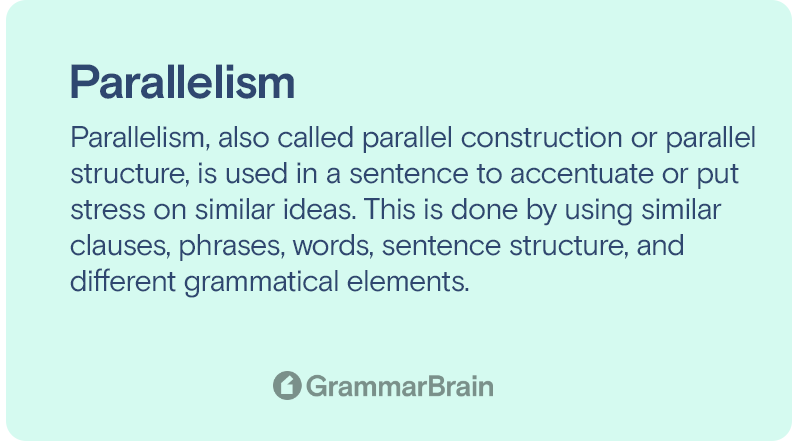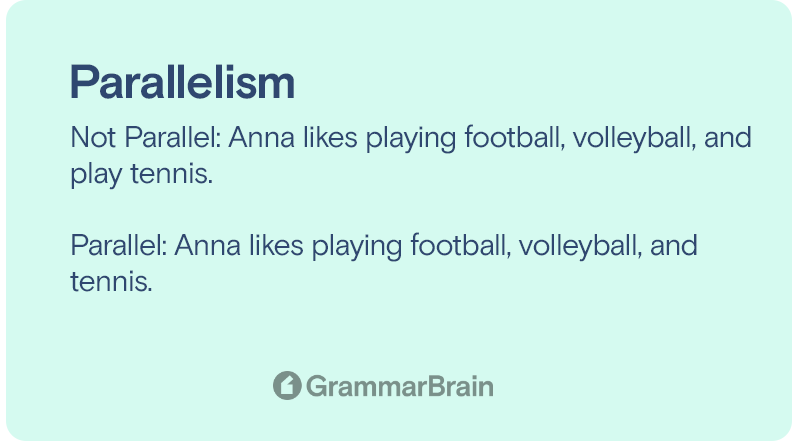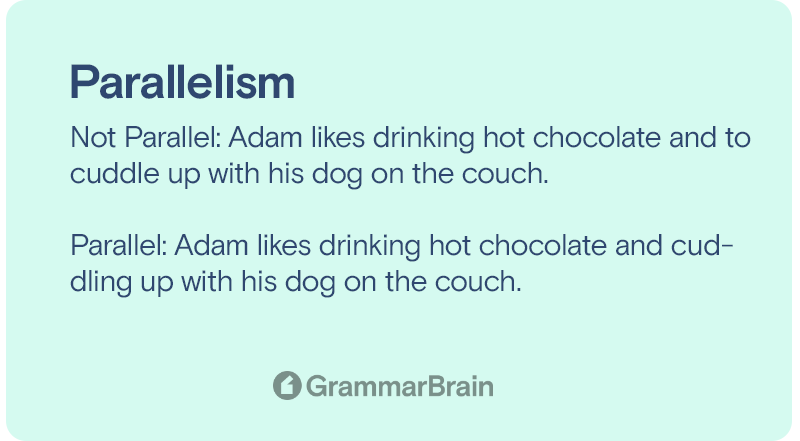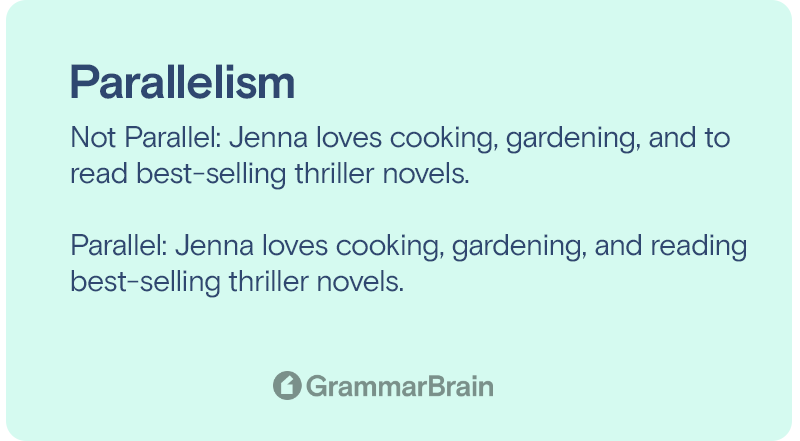What is parallelism? In grammar, parallelism, also known as parallel construction, is a balance within one ore more sentences or similar phrases (and clauses) that have the grammatical structure. Learn more about parallelism in this complete grammar guide.

What is parallelism (and parallel structure)?
Parallelism, also called parallel construction or parallel structure, is used in a sentence to accentuate or put stress on similar ideas. This is done by using similar clauses, phrases, words, sentence structure, and different grammatical elements. The use of parallelism has an impact on readability. The sentences become clear, succinct, and easier to read.
| Not parallel | Parallel |
| I like to run, bake, play music, and watching movies. | I like to run, bake, play music, and watch movies. I like running, baking, playing music, and watching movies. |
Examples of parallelism
Here are examples of parallelism and parallel structure:

Example 1:
- Not Parallel: Anna likes playing football, volleyball, and play tennis.
- Parallel: Anna likes playing football, volleyball, and tennis.
- Parallel: Anna likes to play football, volleyball, and tennis.

Example 2:
- Not Parallel: Adam likes drinking hot chocolate and to cuddle up with his dog on the couch.
- Parallel: Adam likes drinking hot chocolate and cuddling up with his dog on the couch.
- Parallel: Adam likes to drink hot chocolate and cuddle up with his dog on the couch.

Example 3:
- Not Parallel: Jenna loves cooking, gardening, and to read best-selling thriller novels.
- Parallel: Jenna loves cooking, gardening, and reading best-selling thriller novels.
- Parallel: Jenna loves to cook, garden, and read best-selling thriller novels.
Even though the sentences may seem grammatically correct without parallelism, using parallel construction enhances the readability of the sentence.
Creating parallel construction
The use of parallelism guarantees that similar phrases or clauses have the same meaning and purpose. When writing a sentence, it is crucial to consistently employ the same noun, verb, adjective, or adverb forms throughout to create parallelism.
Consider the sentences given below:
- Jenna loves cooking, gardening, and reading best-selling thriller novels.
- Jenna loves to cook, gardening, and read best-selling thriller novels.
In the first sentence, “Jenna loves cooking, gardening, and reading best-selling thriller novels,” all of Jenna’s favorite activities are expressed as gerunds. Gerunds are verbs expressed in their “-ing” forms that serve as nouns.
Using gerunds throughout the sentence maintains parallelism. In the second sentence, “Jenna loves to cook, gardening, and read best-selling thriller novels,” all of Jenna’s favorite activities are expressed in an inconsistent manner.
As a result, the sentence feels awkward and has less flow. The reader needs to put in more effort to comprehend the meaning of the sentence.
Situations requiring the use of parallel construction
In English grammar, there are several situations that require the use of parallel construction. Some of them include:
With series or lists
Use parallel construction for comparing things in a list. All lists or series of things, actions, or qualities must follow identical grammatical forms.
Examples:
- Not Parallel: Calliope loves reading romance novels, going for morning hikes, and to cook exotic dishes.
- Parallel: Calliope loves reading romance novels, going for morning hikes, and cooking exotic dishes.
- Parallel: Calliope loves to read romance novels, go for morning hikes, and cook exotic dishes.
- Point to note: Sometimes the list starts with prepositions like “in,” “at,” “to,” “on,” and “of”. In this case, use it either at the beginning of the series or list or use it before each item.
Examples:
- Calliope loves to read romance novels, go for morning hikes, and cook exotic dishes.
- Connor is of British, German, and Asian ancestry.
- The tailoring class was a good place for learning to stitch clothes and to make new friends.
Sentences that describe chronological events
Consistent verb tenses that represent the order of the actions or events must be used in sentences that describe chronological events.
Examples:
- Not Parallel: Lily stopped looking at the instructions of the automatic kneader and starts kneading the dough with her hand.
- Parallel: Lily stopped looking at the instructions of the automatic kneader and started kneading the dough with her hand.
The sentence above describes something that has already happened. This means all the verbs used in it should be in the past tense.
With clauses or phrases of comparison
Use parallel construction when joining two phrases or clauses with words showing comparison like “as” or “than”.
Example:
- Not Parallel: Malcolm would rather die for his country than humiliated by surrendering.
- Parallel: Malcolm would rather die for his country than get humiliated by surrendering.
Phrases or clauses joined using correlative conjunctions
Correlative conjunctions comprise sentence patterns like “not only/but also,” “neither/nor,” “either/or,” “whether/or,” or “both/and”. Parallel construction should be used with these correlative conjunctions.
Examples:
- Not Parallel: My cat not only loves to catch mice, but also play fetch.
- Parallel: My cat not only loves to catch mice, but she also loves to play fetch.
- Parallel: My cat loves not only catching mice but also playing fetch.
Phrases or clauses joined using coordinating conjunctions
Use parallel construction when joining phrases or clauses with coordinating conjunctions like “for,” “and,” “or,” “yet,” “but,” or “so”.
Examples:
- Not Parallel: Lily’s boyfriend took her dancing and to a club.
- Parallel: Lily’s boyfriend took her to a dance and a club.
FAQs
How can parallelism be used in proofreading?
While proofreading, parallelism can be used to eliminate repetition.
Example:
- Faulty: Mary picked up her wallet. Mary picked up her laptop. Mary picked up her lunch box.
- Parallel: Mary picked up her wallet, laptop, and lunch box.
- Faulty: He likes to exercise during the day and the night.
- Parallel: He likes to exercise during the day and night.
How can parallelism be used for improving clarity?
Consider the following sentence:
Cassandra is fascinated by medieval European literature and art.
In this sentence, the reader may get confused about whether Cassandra is interested in art in general or medieval European art specifically. This can be avoided by using the phrase “medieval European” one more time while still maintaining parallelism.
Corrected sentence: Cassandra is fascinated by medieval European literature and medieval European art.
Sources:
- Merriam Webster – parallelism – Definition
- Wikipedia – Parallelism (grammar)
- Grammarly – What is Parallelism in Grammar?
- University of Lynchburg – Parallelism
Inside this article
Fact checked:
Content is rigorously reviewed by a team of qualified and experienced fact checkers. Fact checkers review articles for factual accuracy, relevance, and timeliness. Learn more.
Core lessons
Glossary
- Abstract Noun
- Accusative Case
- Anecdote
- Antonym
- Active Sentence
- Adverb
- Adjective
- Allegory
- Alliteration
- Adjective Clause
- Adjective Phrase
- Ampersand
- Anastrophe
- Adverbial Clause
- Appositive Phrase
- Clause
- Compound Adjective
- Complex Sentence
- Compound Words
- Compound Predicate
- Common Noun
- Comparative Adjective
- Comparative and Superlative
- Compound Noun
- Compound Subject
- Compound Sentence
- Copular Verb
- Collective Noun
- Colloquialism
- Conciseness
- Consonance
- Conditional
- Concrete Noun
- Conjunction
- Conjugation
- Conditional Sentence
- Comma Splice
- Correlative Conjunction
- Coordinating Conjunction
- Coordinate Adjective
- Cumulative Adjective
- Dative Case
- Determiner
- Declarative Sentence
- Declarative Statement
- Direct Object Pronoun
- Direct Object
- Diction
- Diphthong
- Dangling Modifier
- Demonstrative Pronoun
- Demonstrative Adjective
- Direct Characterization
- Definite Article
- Doublespeak
- False Dilemma Fallacy
- Future Perfect Progressive
- Future Simple
- Future Perfect Continuous
- Future Perfect
- First Conditional
- Irregular Adjective
- Irregular Verb
- Imperative Sentence
- Indefinite Article
- Intransitive Verb
- Introductory Phrase
- Indefinite Pronoun
- Indirect Characterization
- Interrogative Sentence
- Intensive Pronoun
- Inanimate Object
- Indefinite Tense
- Infinitive Phrase
- Interjection
- Intensifier
- Infinitive
- Indicative Mood
- Participle
- Parallelism
- Prepositional Phrase
- Past Simple Tense
- Past Continuous Tense
- Past Perfect Tense
- Past Progressive Tense
- Present Simple Tense
- Present Perfect Tense
- Personal Pronoun
- Personification
- Persuasive Writing
- Parallel Structure
- Phrasal Verb
- Predicate Adjective
- Predicate Nominative
- Phonetic Language
- Plural Noun
- Punctuation
- Punctuation Marks
- Preposition
- Preposition of Place
- Parts of Speech
- Possessive Adjective
- Possessive Determiner
- Possessive Case
- Possessive Noun
- Proper Adjective
- Proper Noun
- Present Participle
- Prefix
- Predicate



